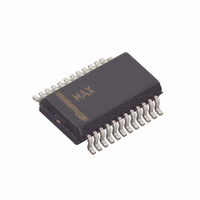MAX1858EEG+ Maxim Integrated Products, MAX1858EEG+ Datasheet - Page 11

MAX1858EEG+
Manufacturer Part Number
MAX1858EEG+
Description
IC CNTRLR BUCK DUAL 24-QSOP
Manufacturer
Maxim Integrated Products
Type
Step-Down (Buck)r
Datasheet
1.MAX1858EEG.pdf
(21 pages)
Specifications of MAX1858EEG+
Internal Switch(s)
No
Synchronous Rectifier
No
Number Of Outputs
2
Voltage - Output
0 ~ 18 V
Current - Output
10A
Frequency - Switching
100kHz ~ 600kHz
Voltage - Input
4.75 ~ 23 V
Operating Temperature
-40°C ~ 85°C
Mounting Type
Surface Mount
Package / Case
24-QSOP
Power - Output
762mW
Lead Free Status / RoHS Status
Lead free / RoHS Compliant
Figure 3. Reducing the Switching-Node Rise Time
On the rising edge of EN both controllers enter soft-
start. Soft-start gradually ramps up to the reference
voltage seen by the error amplifier in order to control
the outputs’ rate of rise and reduce input surge cur-
rents during startup. The soft-start period is 1024 clock
cycles (1024/f
ramps up the voltage in 64 steps. The output reaches
regulation when soft-start is completed. On the falling
edge of EN both controllers simultaneously enter soft-
stop, which reverses the soft-start ramp. The part
enters shutdown after soft-stop is complete.
After the startup circuitry enables the controller, the
MAX1858 begins the startup sequence. Regulator 1
(OUT1) powers up with soft-start enabled. Once the first
converter’s soft-start sequence ends, Regulator 2 (OUT2)
powers up with soft-start enabled. Finally, when both con-
verters complete soft-start and both output voltages
exceed 90% of their nominal values, the reset output
(RST) goes high (see the Reset Output section). Soft-stop
is initiated by pulling EN low. Soft-stop occurs in reverse
order of soft-start, allowing last-on/first-off operation.
RST is an open-drain output. RST pulls low when either
output falls below 90% of its nominal regulation voltage.
Once both outputs exceed 90% of their nominal regula-
tion voltages and both soft-start cycles are completed,
RST goes high impedance. To obtain a logic-voltage out-
put, connect a pullup resistor from RST to the logic sup-
______________________________________________________________________________________________________
MAX1858
Controller with Power Sequencing and POR
BST_
DH_
LX_
V
SW
L
), and the internal soft-start DAC
Dual 180° Out-of-Phase PWM Step-Down
5Ω
Output-Voltage Sequencing
INPUT
(V
IN
Reset Output
)
ply voltage. A 100kΩ resistor works well for most appli-
cations. If unused, leave RST grounded or unconnected.
SYNC serves two functions: SYNC selects the clock out-
put (CKO) type used to synchronize slave controllers, or
it serves as a clock input so the MAX1858 can be syn-
chronized with an external clock signal. This allows the
MAX1858 to function as either a master or slave. CKO
provides a clock signal synchronized to the MAX1858’s
switching frequency, allowing either in-phase (SYNC =
GND) or 90° out-of-phase (SYNC = V
of additional DC-DC controllers (Figure 5). The
MAX1858 supports the following three operating modes:
• SYNC = GND: The CKO output frequency equals
• SYNC = V
• SYNC Driven by External Oscillator: The controller
Thermal overload protection limits total power dissipation
in the MAX1858. When the device’s die-junction tempera-
ture exceeds T
shuts down the device, forcing DL_ and DH_ low, allow-
ing the IC to cool. The thermal sensor turns the part on
again after the junction temperature cools by 10°C.
During thermal shutdown, the regulators shut down, RST
goes low, and soft-start is reset. If the V
output is short-circuited, thermal-overload protection is
triggered.
REG1’s switching frequency (f
CKO signal is in phase with REG1’s switching fre-
quency. This provides 2-phase operation when syn-
chronized with a second slave controller.
times REG1’s switching frequency (f
and the CKO signal is phase shifted by 90° with
respect to REG1’s switching frequency. This pro-
vides 4-phase operation when synchronized with a
second MAX1858 (slave controller).
generates the clock signal by dividing down the
SYNC input signal, so the switching frequency equals
half the synchronization frequency (f
REG1’s conversion cycles initiate on the rising edge
of the internal clock signal. The CKO output frequen-
cy and phase match REG1’s switching frequency
(f
that the MAX1858 still requires R
externally clocked and the internal oscillator frequen-
cy should be set to 50% of the synchronization fre-
quency (f
CKO
Clock Synchronization (SYNC, CKO)
= f
DH1
OSC
L
: The CKO output frequency equals two
J
) and the CKO signal is in phase. Note
= 0.5f
= +160°C, an on-chip thermal sensor
Thermal Overload Protection
SYNC
).
CKO
OSC
L
) synchronization
= f
L
SW
when SYNC is
linear-regulator
CKO
DH1
= f
) and the
= 2f
SYNC
DH1
/2).
11
)











